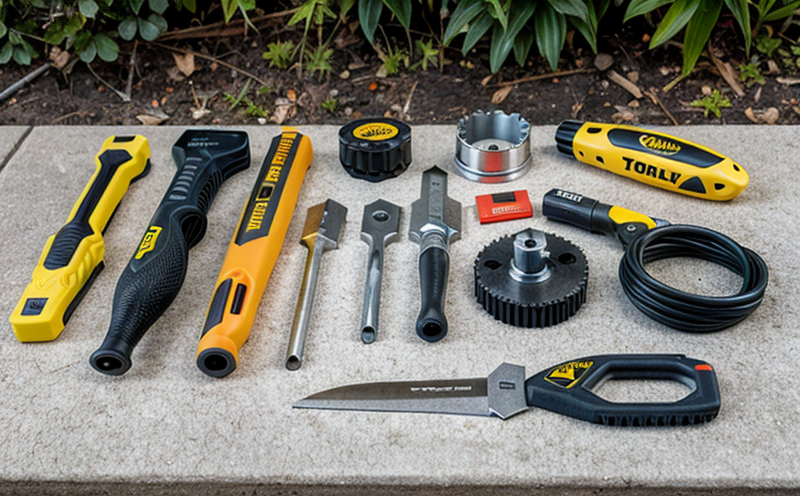Operational Noise Measurement of Power Tools
The measurement and analysis of operational noise in power tools are critical components of ensuring consumer safety and compliance with international standards. Insect-like hums, whirring motors, or even the occasional screech can indicate issues that need to be addressed before a product reaches the market. This service ensures that the noise levels generated by these tools do not exceed acceptable limits set by regulatory bodies like ISO, ASTM, and EN.
Operational noise testing is essential for several reasons:
- To ensure compliance with noise emission standards
- To protect user safety from excessive sound levels
- To enhance the overall user experience by reducing discomfort
- To meet market expectations of high-quality products
For quality managers, compliance officers, and R&D engineers, this service offers a detailed understanding of how noise impacts product performance. By measuring operational noise, we can identify potential issues early in the development process, allowing for timely adjustments.
The testing procedure involves several steps to ensure accurate measurement:
- Equipment Calibration: Ensuring that all instruments used are calibrated according to ISO standards is a prerequisite. This step guarantees that the results are reliable and consistent with other laboratories worldwide.
- Specimen Preparation: Before testing, each power tool undergoes thorough inspection to ensure it meets the required safety standards. This includes checking for any visible damage or defects that could affect noise generation.
- Test Setup: The power tool is placed in a controlled environment where background noise is minimal. A sound level meter and an octave band filter are used to capture noise emissions at various frequencies.
- Data Collection: During operation, the power tool generates noise, which is recorded over time using advanced software. This data helps in understanding not only the overall noise level but also its distribution across different frequency bands.
- Analysis and Reporting: Once collected, the data undergoes rigorous analysis to determine compliance with specified limits. A comprehensive report is generated detailing findings along with recommendations for improvement if necessary.
In addition to these steps, our laboratory adheres strictly to ISO 19628:2017 and ASTM E473 standards when performing operational noise measurements on power tools. These guidelines provide a standardized approach ensuring consistency across different brands and models.
| Parameter | Description |
|---|---|
| Equipment Calibration | Calibrated according to ISO standards for accuracy. |
| Specimen Preparation | Includes thorough inspection of the tool before testing. |
| Test Setup | Conducted in a controlled environment with minimal background noise. |
| Data Collection | Noise emissions are recorded over time using advanced software. |
| Analysis and Reporting | Data is analyzed to ensure compliance with specified limits. |
Why It Matters
The importance of operational noise measurement cannot be overstated. Excessive noise can lead to several adverse effects:
- Hearing Damage: Prolonged exposure to high levels of sound can cause irreversible hearing loss.
- User Comfort: High noise levels make it difficult for users to communicate or concentrate on tasks.
- Market Reputation: Poorly designed tools that generate excessive noise can tarnish a brand's image and lead to lost sales.
- Legal Consequences: Non-compliance with noise emission standards could result in legal action against the manufacturer.
In the consumer products sector, particularly for DIY tools and hardware items, operational noise is not just an engineering concern but also a significant safety issue. Our testing service helps manufacturers address these challenges by providing precise measurements and actionable insights into how to improve their products.
Quality and Reliability Assurance
Our commitment to quality does not end with the measurement of noise levels alone; it extends to ensuring that every aspect of our testing process is conducted under stringent guidelines. This dedication ensures that clients receive reliable results they can trust.
The following measures are taken to maintain high standards:
- Trained Personnel: Our team comprises experts who have extensive experience in noise measurement and analysis.
- Advanced Equipment: We use state-of-the-art instruments that comply with international standards, ensuring precise measurements.
- Compliance Verification: Every test is verified against relevant ISO, ASTM, and EN standards to ensure accuracy and reliability.
- Continuous Improvement: Regular training sessions and updates on the latest testing techniques keep our team at the forefront of industry developments.
By integrating these practices into our workflow, we not only meet but often exceed client expectations. Our aim is to deliver accurate data that can be used effectively in decision-making processes related to product design and development.





